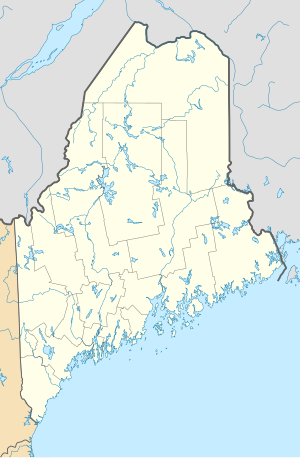Dow Field
| Bangor Air National Guard Base Dow Air Force Base |
|
|---|---|
| Part of Maine Air National Guard (ANG) | |
| Bangor, Maine | |

KC-135 of the 101st Air Refueling Wing at Bangor ANGB
|
|
| Coordinates | 44°48′51″N 068°49′51″W / 44.81417°N 68.83083°WCoordinates: 44°48′51″N 068°49′51″W / 44.81417°N 68.83083°W |
| Type | Air Force Base |
| Site history | |
| Built | 1927 |
| In use | 1953 – present |
Bangor Air National Guard Base is a United States Air National Guard base. Created in 1927 as the commercial Godfrey Field, the airfield was taken over by the U.S. Army just before World War II and renamed Godfrey Army Airfield and later Dow Army Airfield. It became Dow Air Force Base in 1947, when the new U.S. Air Force took over many Army air assets. In 1968, the base was sold to the city of Bangor, Maine, to become Bangor International Airport but has since continued to host Maine Air National Guard units.
Godfrey Field opened in 1927 as a commercial airport. Northeast Airlines began commercial operations there in 1931.
Just before World War II, the United States Army Air Corps took over the base, renamed it Godfrey Army Airfield, and placed it under the 8th Service Group, Air Service Command. Godfrey AAF prepared and maintained the Lend-Lease aircraft that would be flown by AAC Ferrying Command to RCAF Stations in Newfoundland for eventual transport to Britain. The Army expanded the civil airport, adding three hard-surfaced 7,000-foot runways, aligned 01/10 (N/S), 08/26 (NE/SW) and a main (NW/SE) runway aligned 14/32; along with many hardstands and taxiways to allow the temporary parking of large numbers of aircraft.
In 1942, the station's name was changed to Dow Army Airfield to honor James Frederick Dow, an Army Air Corps pilot whose bomber collided with another near Mitchel Field on Long Island, New York, on 17 June 1940. During this time, Milford Auxiliary Airfield was opened nearby at the Bangor Precision Bombing Range.
On 28 February 1942, Dow Army Airfield was transferred to Air Service Command (ASC) because of its proximity to the Air Transport Command (ATC) North Atlantic air ferry route to the United Kingdom. Its mission became servicing long-range B-17 Flying Fortress and, later, B-24 Liberator heavy bombers and other combat aircraft before they flew via the Great Circle Route to Prestwick Airport, Scotland; and airfields in Northern Ireland. (Once in the British isles, the aircraft were modified for combat missions by Eighth Air Force units over Nazi-occupied Europe.) On 5 March 1944, Dow AAF was transferred to Air Transport Command's North Atlantic Wing. In 1944, more than 8,400 aircraft passed though Dow, and about 2,150 in January through May 1945.
...
Wikipedia

